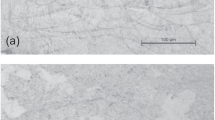Abstract
3J33B maraging steel is a high-strength steel which is used for fabricating precision elastic components. In this paper, experiments were carried out to investigate chip formation, surface roughness, and top burr formation in micro end milling of 3J33B from an energy perspective. Chip formation and surface roughness in the centerline position of the slots were analyzed based on the average specific cutting energy. Surface roughness and burr size of the two sides of the slots were compared to the variation of the instantaneous specific cutting energy in a half cutting revolution. It was found that the chips became more fragmentized with an increase in the specific cutting energy due to the plowing effect. The formation of the down-milling side required more specific energy than that of the up-milling side. It was proven that the increment of the specific energy on the down-milling side was related to the better surface finish and greater size of top burrs. At last, some suggestions on parameter selection for surface improvement were proposed according to the research results.
Similar content being viewed by others
References
Boswell B, Islam MN, Davies IJ (2017) A review of micro-mechanical cutting. Int J Adv Manuf Technol 94(1-4):1–18
Oliveira FBD, Rodrigues AR, Coelho RT, Souza AFD (2015) Size effect and minimum chip thickness in micro-milling. Int J Mach Tools Manuf 89:39–54
Park SS, Malekian M (2009) Mechanistic modeling and accurate measurement of micro end milling forces. CIRP Ann-Manuf Tech 58(1):49–52
Aramcharoen A, Mativenga PT (2009) Size effect and tool geometry in micro-milling of tool steel. Precis Eng 33(4):402–407
Mian AJ (2011) Size effect in micromachining. University of Manchester, Dissertation
Shimada S, Ikawa N, Tanaka H, Ohmori G, Uchikoshi J, Yoshinaga H (1993) Feasibility Study on ultimate accuracy in micro-cutting using molecular dynamics simulation. CIRP Ann-Manuf Tech 42(1):91–94
Vogler MP, Devor RE, Kapoor SG (2004) On the modeling and analysis of machining performance in micro-end-milling, part I: surface generation. J Manuf Sci E 126(4):695–705
Weule H, Hüntrup V, Tritschler H (2001) Micro-cutting of steel to meet new requirements in miniaturization. CIRP Ann-Manuf Tech 50(1):61–64
Cheng K, Huo D (2013) Micro-cutting: fundamentals and applications. John Wiley & Sons Ltd, Chichester
Wu X, Li L, Zhao M, He N (2015) Experimental investigation of specific cutting energy and surface quality based on negative effective rake angle in micro turning. Int J Adv Manuf Technol 82(9–12):1941–1947
Filiz S, Conley CM, Wasserman MB, Ozdoganlar OB (2007) An experimental investigation of micro-machinability of copper 101 using tungsten carbide micro-endmills. Int J Mach Tools Manuf 47(7–8):1088–1100
Shaw MC (2003) The size effect in metal cutting. Sadhana 28(5):875–896
Nakayama K, Tamura K (1965) Size effect in metal cutting force. J Manuf Sci E 31(362):240–249
Zhang T, Liu Z, Shi Z, Xu C (2017) Investigation on size effect of specific cutting energy in mechanical micro-cutting. Int J Adv Manuf Technol 91(5):2621–2633
Atkins AG (2003) Modelling metal cutting using modern ductile fracture mechanics: quantitative explanations for some longstanding problems. Int J Mech Sci 45(2):373–396
Liu X, Devor RE, Kapoor SG (2003) Model-based analysis of the surface generation in the micro-end-milling-part I: model development. J Manuf Sci E-T Asme 129(2):453–460
Son SM, Han SL, Ahn JH (2005) Effects of the friction coefficient on the minimum cutting thickness in micro cutting. Int J Mach Tools Manuf 45(4–5):529–535
Lee K, Dornfeld DA (2005) Micro-burr formation and minimization through process control. Precis Eng 29(2):246–252
Cheng J, Jin Y, Wu J, Wen X, Gong Y, Shi J, Cai G (2016) Experimental study on a novel minimization method of top burr formation in micro-end milling of Ti-6Al-4V. Int J Adv Manuf Technol 86(5–8):1–21
Vipindas K, Kuriachen B, Mathew J (2016) Investigations into the effect of process parameters on surface roughness and burr formation during micro end milling of TI-6AL-4V. Int J Adv Manuf Technol 2:1–16
Sealy MP, Liu ZY, Guo YB, Liu ZQ (2016) Energy based process signature for surface integrity in hard milling. J Mater Process Technol 238:284–289
Qi H, Cheng Z, Cai D, Yin L, Wang Z, Wen D (2018) Experimental study on the improvement of surface integrity of tungsten steel using acoustic levitation polishing. J Mater Process Technol 259:361–367
Guo Y, Loenders J, Duflou J, Lauwers B (2012) Optimization of energy consumption and surface quality in finish turning. Procedia CIRP 1(9):512–517
Balogun VA, Mativenga PT (2016) Specific energy-based characterization of surface integrity in mechanical machining. Procedia Manuf 7:290–296
Balogun VA, Mativenga PT (2014) Impact of un-deformed chip thickness on specific energy in mechanical machining processes. J Clean Prod 69(69):260–268
Yang D, Liu Z (2015) Surface topography analysis and cutting parameters optimization for peripheral milling titanium alloy Ti-6Al-4V. Int J Refract Met H 51:192–200
Funding
This work is supported by the National Natural Science Foundation of China (51675312, U1708256).
Author information
Authors and Affiliations
Corresponding authors
Rights and permissions
About this article
Cite this article
Yao, Y., Zhu, H., Huang, C. et al. Investigation on chip formation and surface integrity in micro end milling of maraging steel. Int J Adv Manuf Technol 102, 1973–1984 (2019). https://doi.org/10.1007/s00170-018-03219-3
Received:
Accepted:
Published:
Issue Date:
DOI: https://doi.org/10.1007/s00170-018-03219-3




